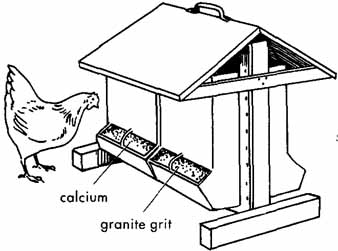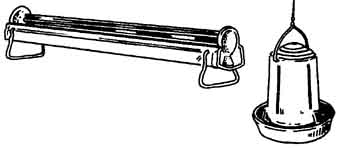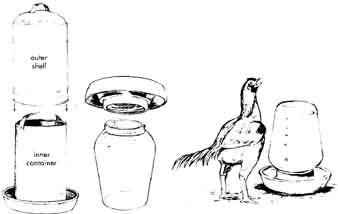Wild jungle fowl, the ancestors of modern chickens, met their nutritional needs by consuming a variety of plants and insects. Given enough room to roam, some of today’s breeds remain active foragers. In most backyard situations, though, chickens are confined to a small area and must be furnished everything they need to enjoy a balanced diet.
Chicken Feed
The easiest way to make sure your chickens eat right is to buy chicken feed or poultry ration at a farm store. Mature chickens should be fed a lay ration containing 16 percent protein plus all the other nutrients they need. Lay ration comes in crumbled or pelleted form. Less feed will be wasted if you use pellets. Since two-thirds of the cost of keeping chickens goes into feed, the less you waste, the lower your cost.
Each chicken eats about 2 pounds of ration per week. Dual-purpose hens eat a bit more, bantams a bit less. All chickens eat less in summer than in winter, when they need extra energy to stay warm.
Lay ration comes in 25- or 50-pound sacks. It’s a good idea to keep a little extra on hand so you won’t run out, but don’t stock up too far ahead. Chicken feed goes stale, especially in warm weather, causing the nutritional value to decrease. Buy only as much as your flock will consume within 2 or 3 weeks.
Chickens love cracked corn or a mixture of grains called scratch, which should be viewed as chicken candy. You can tame a flock by throwing down a handful of scratch whenever you visit your chickens; pretty soon, they will learn to come to you. In cold weather, a little scratch fed late in the day helps keep chickens warm overnight. Too much scratch makes chickens fat, creating lazy layers.
After opening a sack of scratch or lay ration, store the feed in a plastic trash container with a tight-fitting lid. A 10-gallon container holds 50 pounds of feed. The closed container helps prevent feed from getting stale and keeps out mice. Place the container in a cool, dry area, out of the sun. Use up all the feed in the container before opening another sack.
If you buy more feed at a time than will fit into the container, store unopened bags away from moisture and off the floor or ground. Wooden or plastic pallets are ideal for this purpose. Avoid attracting rodents by keeping your feed storage area swept clean. To prevent mice from nibbling holes in your feed sacks and inviting their cousins to dinner, reduce the rodent population by frequently setting traps.
Reducing Feed Costs
You can reduce the cost of buying feed by treating your chickens to leftover table scraps and garden produce. Chickens love tomatoes, lettuce, apple parings, bits of toast, and other tasty treats from the kitchen. Take care, though, to avoid strong- tasting foods such as onions, garlic, or fish, which will give an off flavor to eggs and meat. Don’t feed chickens anything that has spoiled or rotted. And avoid feeding raw potato peelings, which are not digestible. If you wish to feed potato peelings cook them first. Do not rely on table scraps as your flock’s sole source of food.
Another way to reduce the cost of feed is to let your chickens roam on a lawn or in a pasture for part of the day. By eating plants, seeds, and insects, they will balance their diet and eat less of the expensive commercial stuff. Take care not to put your chickens on grass or around buildings that have been sprayed with toxins.
How much you save on commercial rations by allowing your chickens to forage depends on the quantity and quality of the forage, which varies seasonally. Some layer flocks can survive entirely on forage. Broilers, on the other hand, would grow much more slowly and in the long run may end up costing more per pound.
Supplements
Eggshells are made of calcium. To lay eggs with hard shells, a hen needs adequate calcium in her diet. Lay ration contains enough calcium for pullets, and hens that forage freely find plenty of calcium in the form of hard-shelled insects. Older hens that do not forage need supplemental calcium to keep them from laying thin- shelled eggs that break easily.
Farm stores carry supplemental calcium in the form of ground oyster shell or lime stone (but do not feed dolomitic limestone, which can harm egg production). Place the calcium supplement in a hopper where your hens can eat as much as they want.
Fill a second hopper with granite grit, which chickens need to eat because they have no teeth. Everything the chicken eats passes through the gizzard; the grit lodges in the gizzard and grinds feed up finely enough to be digestible. Foraging chickens may find sufficient pebbles and sand to use as grit, but you can’t count on their finding enough.
Granite grit is sometimes called insoluble grit, meaning it wears down over time rather than dissolving. Calcium supplements, by contrast, are sometimes called soluble grit, because the particles are hard and may temporarily serve the same purpose as grit until they dissolve. This distinction may be important in making sure you get the right thing when you ask for grit at the farm store.

Two double-sided hoppers, one for calcium and one for
granite grit, hang side by side.
Feeders
Eating is chickens’ main activity. They like to peck a little here and a little there, eating all day long, which works fine for chickens that can forage. If chickens that have all their feed brought to them are allowed to go hungry, they soon start pecking on one another, which leads to trouble. Confined chickens should be fed free choice so they can eat whenever they want to. Free-choice feeding requires a large enough feeder to ensure that your flock won’t run out of rations before the next feeding.
Feeders come in many designs, but good ones share important features:
• They are designed to discourage chickens from sitting on top and messing in the feed.
• They are designed to prevent billing out, a habit chickens have of using their beaks to scoop feed onto the ground, where it is wasted. Billing out is discouraged by a feeder with edges that roll or bend inward.
• They are easy to clean.
• Their height may be adjusted to suit the chickens’ size. A hanging feeder works well because the chain from which it hangs may be shortened as the chickens grow. The ideal is to place feed at the height of the chickens’ backs.
A typical hanging feeder consists of a bucket-shaped container, open at both ends, with a shallow dish attached at the bottom and a handle at the top from which the feeder is hung. Feed is poured in at the top, and as the chickens eat from around the dish, gravity causes more feed to replace that which has been eaten. Not all feeders have lids, but they should, to keep the droppings from chickens that roost on the feeder from getting into the feed. If your feeder lacks a lid, fashion one from the lid of a 5-gallon bucket by notching out two sides to fit under the handle.
As a rule of thumb, one hanging feeder is enough for up to 30 chickens. If you use a trough feeder, allow 4 inches in trough length for each bird; if chickens can eat from both sides of the trough, allow 2 inches for each bird.
Another rule of thumb is to f enough feeder space so all your chickens can eat at the same time. Otherwise, the lowest-ranking chickens in the peck order will get pushed aside and go hungry. You can’t go wrong by providing more than the minimum feeder space, but you can go wrong by providing too little.
If your flock includes more than one cock, provide one feeder per cock and place the feeders at least 10 feet apart. Each cock will claim a feeder and entice some of the hens to join him, r competition between the males and thus reducing fights.
Avoid Moldy Rations: Wet feed soon goes moldy and can cause illness. If feed gets wet, dispose of it and scrub out the feeder before filling it with fresh ration.

This trough has adjustable legs to increase or decrease
the trough’s height as well as an anti-roosting reel that will spin and
dump any bird that tries to hop up on top of it. (right) This hanging
tube type feeder has raised sides of the bottom to prevent billing out.
Water
The most important part of your flock’s diet is water. Chickens must be able to drink whenever they desire. A chicken can’t drink much at once, so it has to drink often. Depending on the weather and on the chicken’s size, each bird will drink 1 to 2 cups of water per day.
When the temperature gets above 80°F, chickens may drink two to four times more than usual. Provide fresh cool water several times a day to encourage drinking.
In cold weather, chickens will drink less than normal, but they still need water. To make sure they drink enough when the weather is cold enough to freeze their water, provide warm water several times a day. If your coop has electricity, use a water- warming device from the farm store to keep the drinking water from freezing.
Like feeders, waterers come in many designs. The best waterer holds enough that your flock doesn’t run out before you have a chance to supply more. It keeps the water clean by not allowing chickens to step in it or to roost over it.
The worst kind of waterer is a rain puddle. Chickens will walk in it, mess in it, drink from it, and get sick. Even if you provide plenty of clean drinking water, your chickens will drink from puddles if they can. Avoid puddles by filling areas of standing water with dirt, sand, or gravel. Since chickens love to dig dust holes in the yard, and dust holes become puddles in wet weather, filling puddles in the chicken yard is a never-ending job.

(left) Metal waterer: Fill the inner container with
water, then slide the outer shell over it. (right) Plastic waterer: Fill
the container with water, screw on the base, and flip it over.
Automatic waterers are wonderful. Every time a chicken takes a sip, fresh clean water flows in. The water is always clean, and the waterer is always full. All you have to do is check every day to make sure nothing has clogged the waterer and clean out the water bowl or trough once a week. The farther your waterers are from the feeders, the less feed your chickens will get in their water and the less often you will have to clean the waterers. Farm stores and poultry supply catalogs carry automatic waterers. They are not expensive, but piping water to your chicken coop may be.
The least expensive kind of waterer is made of plastic and holds 1 gallon. Fill the container, screw on the base, and turn the waterer over. Each time a chicken drinks, water runs out of the container through a little hole in the base. Plastic waterers don’t hold up well, especially when left outside in the sun or in freezing weather, so be prepared to replace them often.
A bit more expensive is a metal waterer consisting of an inner container and an outer shell. The inner container has a basin at the bottom. ‘When you fill the inner container and slip on the outer shell, the shell presses against a clip that lets water flow into the basin. This style comes in a 3-gallon size and a 5-gallon size. They eventually rust out, but sometimes you can keep one going a little longer by patching holes with epoxy.
In the summer, locate waterers in the shade where the water won’t be warmed by the sun. In winter, put water in the sun to help prevent freezing. If your flock includes more than one cock, provide one waterer per cock, just as with feeders, creating a separate territory for each male.
Provide drainage beneath each waterer to prevent standing puddles in the event of spillage. A bed of sand or gravel beneath the waterer will improve drainage. Make a small platform by nailing together a wooden frame, 42 inches wide by 42 inches long by 12 inches high. Staple strong wire mesh to the top. Set the platform on the sand or gravel, and place the waterer on top of the platform. Any spills will fall through the wire, to be absorbed into the sand or gravel. Your chickens will stay healthier because they won’t be able to drink dirty water from the ground.
Next: Egg Production
Prev.: Housing Chickens